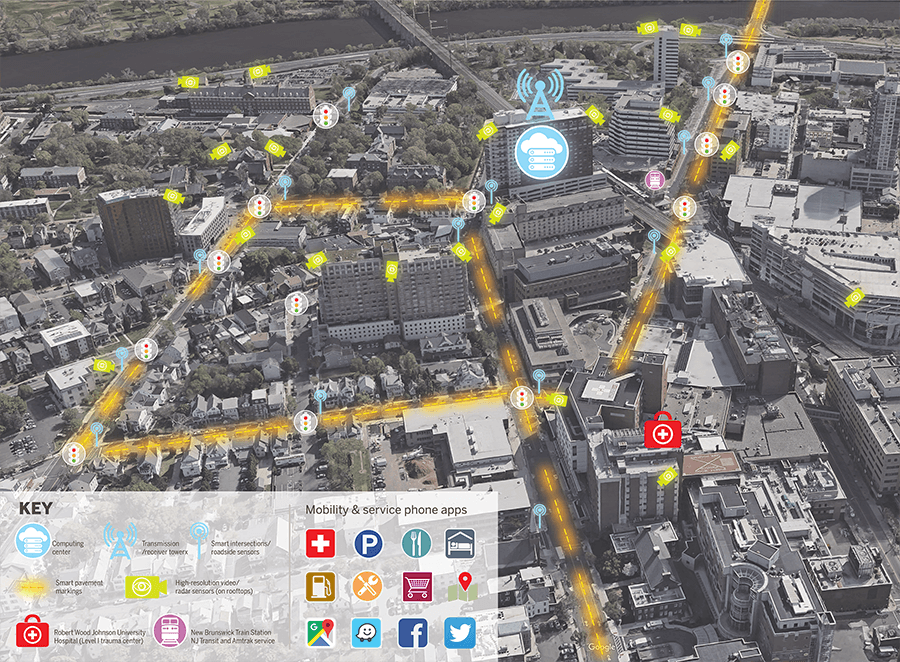The acquisition and analysis of mobility data is crucial to integrating autonomous vehicles, creating a safer pedestrian and cycling environment, and fostering robust public transit. CAIT, in partnership with public agencies and the private sector, plans to turn a 12-acre area of downtown New Brunswick into a test bed for high-resolution mobility data-gathering, analysis, and sharing technologies that will help implement autonomous vehicle systems (VtoX) in the future.
Governor Phil Murphy has made reclaiming New Jersey’s historical position as a capital of American innovation and invention a cornerstone of his “Stronger and Fairer” economic development agenda.
One aspect of his vision for the state’s future economy included, among others, creating a large-scale Innovation Hub that would build partnerships between the public sector, institutions of higher education, real estate developers, and entrepreneurial private sector leaders. The Innovation Hub would encourage technological research and cutting-edge tech startups. CAIT will be there to help make it happen.
“By creating a site where high-growth industry can thrive, New Jersey will begin to foster new ideas and take advantage of the once-in-a-generation chance to remake the state as an engine of economic opportunity,” Murphy said in a New Jersey Business interview.
Murphy pointed out that New Jersey and its cities have limited access to incubators and other supportive real estate components that foster the growth and development of start-ups. New Jersey’s cities also need to develop infrastructure strategies that support the “city of the future,” including mobility, walkability, bike-ability, transit-oriented development, fiber/broadband, and utility infrastructure—areas that are all in CAIT’s wheelhouse.
In September 2018, the New Jersey Economic Development Authority (EDA) awarded nine grants of up to $100,000 to the highest scoring proposals submitted in response to a competitive Request for Qualifications/Proposals (RFQ/P). Characteristics of the solicited plans had to include specific deliverables, clearly define components that support inclusive economic development, and create or enhance the local ecosystem. Guidelines suggested a focus on goals of the Innovation Challenge Program:
- Driving inclusive economic growth and increasing opportunities to build wealth
- Improving supportive infrastructure, such as broadband capacity, walkability, or access to public transit
- Growing the number of local small startups
- Providing better access to STEM jobs and ladders of opportunity
- Attracting top talent and employers
- Increase commercial activity in under-developed metro areas
- Building an entrepreneurial culture

Rutgers researchers plan to outfit the designated area with high-resolution digital and radar cameras, smart intersections and pavement markings, and other mobility data-gathering and data-exchange technologies that will facilitate vehicle-to-vehicle, vehicle-to-infrastructure, and other multimodal communications. (Click to enlarge the Illustration) ©Rutgers CAIT/A. Thomas.
CAIT’s proposal was selected for one of the grants. It put forth a plan to establish a 12-acre area in downtown New Brunswick as a living laboratory comprising an extensive network of sensors and the computing infrastructure to process, analyze, and make use of vast amounts of mobility data.
CAIT director Ali Maher explained “The concept—developed in partnership with the New Brunswick Development Corp. (DEVCO) and the City of New Brunswick—described the corridor as a test bed for developing future technologies and applications that will be needed to make the transition from our present infrastructure and vehicles, to an autonomous, fully connected and coordinated multimodal transportation environment.
“New Brunswick is tailor-made for this initiative because of its ideal confluence of high-density multimodal transportation systems, including the Northeast corridor rail line; world-class healthcare institutions; an established corporate community; and, of course, Rutgers, the state’s premier public research university,” said Maher.
Prabhas Moghe, vice chancellor for research and innovation at Rutgers, reinforces why New Brunswick is a great location for the hub: “…You have this, in some sense, perfect opportunity [that capitalizes on the proximity of] a world-class university, a great medical complex, corporations, and the reach of multimodal transit.”
Rutgers researchers plan to outfit the designated area with high-resolution digital and radar cameras, smart intersections and pavement markings, and other mobility data-gathering and data-exchange technologies that will facilitate vehicle-to-vehicle, vehicle-to-infrastructure, and other multimodal communications. Dr. Peter Jin, the primary author of the proposal, said there are two major components of smart mobility solutions: advanced driver assistance systems (ADAS) and automated driving systems (ADS).
Mobility data analysis and sharing technologies will facilitate autonomous vehicle systems (VtoX), while creating safer environment for all road users, and optimizing public transit options.
June 2019

A rendering of a section of the New Brunswick Innovation Hub. Image courtesy of NJBIZ magazine.

